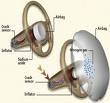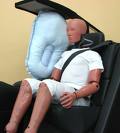SRS SYSTEM BACKGROUND An air bag is an inflatable cushion designed to protect automobiles occupants from serious injury in the case of a collision. The air bag is part of an inflatable restraint system. also known as an air cushion restraint system (ACRS) or an air bag supplemental restraint system (SRS), because the air bag is designed to supplement the protection offered by seat belts. Seat belts are still needed to hold the occupant securely in place, especially in side impacts, rear impacts, and rollovers. Upon detecting a collision, air bags inflate instantly to cushion the exposed occupant with a big gas filled pillow. A typical air bag system consists of an air bag module (containing an inflator or gas generator and an air bag), crash sensors, a diagnostic monitoring unit, a steering wheel connecting coil, and an indicator lamp. These components are all interconnected by a wiring harness and powered by the vehicle's battery. Air bag systems hold a reserve charge after the ignition has been turned off or after the battery has been disconnected. Depending on the model, the backup power supply lasts between one second and ten minutes. Since components vital to the system's operation might sit dorant for years, the air bag circuitry performs an internal "self-test" during each startup, usually indicated by a light on the instrument panel that glows briefly at each startup. The crash sensors are designed to prevent the air bag from inflating when the car goes over a bump or a pothole, or in the case of a minor collision. The inflator fits into a module consisting of a woven nylon bag and a break-away plastic horn pad cover. The module, in turn, fits into the steering wheel for driver's-side application and above the glove compartment for front passenger applications. In a frontal collision equivalent to hitting a solid barrier at nine miles per hour, the crash sensors located in the front of the car detect the sudden deceleration and send an electrical signal activating an initiator (ignitor). Like a light bulb, an initiator contains a thin wire that heats up and penetrates the propellant chamber. This causes the solid chemical propellant, principally sodium azide, sealed inside the inflator to undergo a rapid chemical reaction (commonly referred to as a pyrotechnic chain). This controlled reaction produces harmless nitrogen gas that fills the air bag. During deployment the expanding nitrogen gas undergoes a process that reduces the temperature and removes most of the combustion residue or ash. The expanding nitrogen gas inflates the nylon bag in less than one-twentieth (1/20) of a second, splitting open its plastic module cover and inflating in front of the occupant. As the occupant contacts the bag, the nitrogen gas is vented through openings in the back of the bag. The bag is fully inflated for only one-tenth (1/10) of a second and is nearly deflated by three-tenths (3/10) of a second after impact. Talcum powder or corn starch is used to line the inside of the air bag and is released from the air bag as it is opened. |
History The air bag traces its origin to air-filled bladders outlined as early as 1941 and first patented in the 1950's. Early air bag system were large and bulky, primarily using tanks of compressed or heated air, compressed nitrogen gas (N2), Freon, or carbon dioxide (CO2). Some of the early systems created hazardous byproducts. One particular system used gun-powder to heat up Freon gas, producing phosqene gas (COCI2)-an extremely poisonous gas. One of the first patents for automobile air bags was awarded to industrial engineer John Hetrick on August 18, 1953. Concieved by Hetrick after a near accident in 1952, the design called for a tank of compressed air under the hood and inflatable bags on the steering wheel, in the middle of the dash-board, and in the glove compartment to protect front seat occupants, and on the back of the front seat to protect rear seat passenger. The force of a colision of a collision would propel a sliding weight forward to send air into the bags. Many other inventors and researchers followed suit, all exploring slightly different designs, so that the exact technical trail from the early designs to the present system is impossible to note with certainty. In 1968, John Pietz, a chemist for Talley Defense Systems, Pioneered a solid propellant using sodium azide (NaN3) and a metallic oxide. This was the first nitrogen-generating solid propellant, and it soon replaced the older, bulkier systems. Sodium azide in its solid state is toxic if ingested in large doses, but in automotive applications is carefully sealed inside a steel or aluminum container within the air bag system. Since the 1960's, air bag-equipped cars in controlled tests and everday use have demonstrated the effectiveness and reliability. The Insurance Institute for Highway Safety conducted a study of the federal government's fatal accident reporting system using data from 1985 to 1991, and concluded that driver fatalities in frontal collisions were lowered by 28 percent in automobiles equipped with air bags. According to another study conducted in 1989 by General Motors, the combination of lap/shoulder safety belts and air bags in frontal collisions reduced driver fatalities by 46 percent and front passenger fatalities by 43 percent. In response to consumers' increased safety concerns and insurance industry pressure, the federal government has forced automobile manufacturers to upgrade their safety features. First, Department of Transportation (DOT) regulations require all cars, beginning with model year 1990, sold in the United States to be equipped with a passive restraint system. (Passive restraint systems-requiring no activation by the occupant-involve the use of automatic seat belts and / or the use of air bags. If car manufacturers choose an air bag, then regulations require only a driver's-side system until model year 1994, when air bag-equipped cars must include passive protection on the passenger's side as well. A 1991 law requires driver and passenger air bags in all cars by the 1998 model year and in light trucks and vans by 1999.
|
THE FUTURE The future for air bags looks extremely promising because there are many different applications possible, ranging from aircraft seating to motorcycle helmets. The air bags of the future will be more economical to produce and lighter in weight; will involve smaller, more integrated systems; and will use improved sensors. Side-impact air bags are another possibility that would work similar to driver- and passenger- side air bags. Side-impact air bags will most likely be mounted in the car door panels and deployed towards the window duringimpact to protect the head. Foam padding around the door structure would also be used to cushion the upper body in a side impact. Head and /or knee bolsters (energy absorbing pads) to complement the air bag system are also being investigated. Rear-seat air bags are also being tested but consumer demand is not expected to be high. Aftermarket air bag systems-generic systems that can be installed on any vehicle already built-are not currently available. Since the effectiveness of an air bag depends on its sensors recognizing if a crash is server enough to trigger deployment, a system must be precisely tuned to the way a specific car model behaves in a crash. Still, companies are exploring the future possibility of producing a modified air bag system for retrofit. A hybrid inflator is currently being tested that uses a combination of pressurized inert gas (argon) and heat from a propellant to significantly expand the gas's volume. These systems would have a cost advantage, since less propellant could be used. Air bag manufacturers are also developing systems that would eliminate the sodium azide propellant, which is toxic in its undeployed form. Work is also underway to improve the coatings that preserve the air bag and facilitate its opening. Eventually the bags may not need coatings at all. In the future, more sophisticated sensors called "smart" sensors will be used to tailor the deployment of the air bag to certain conditions. These sensors could be used to sense the size and weight of the occupant, whether the occupant is present and the proximity of the driver to the steering wheel.
|










